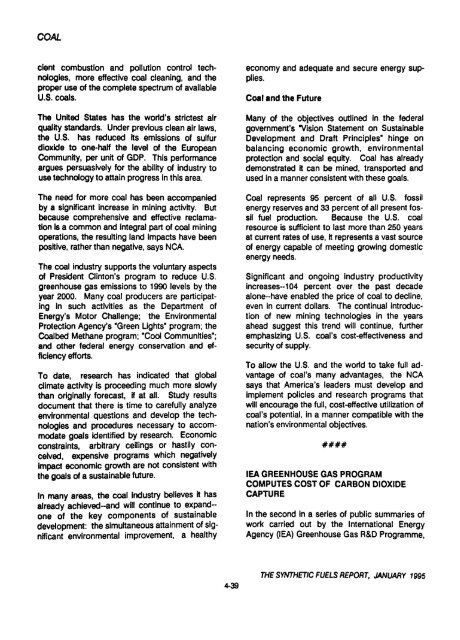Ikelic - Alliance Digital Repository
Ikelic - Alliance Digital Repository
Ikelic - Alliance Digital Repository
Create successful ePaper yourself
Turn your PDF publications into a flip-book with our unique Google optimized e-Paper software.
COAL<br />
cient combustion and pollution control tech<br />
nologies, more effective coal cleaning, and the<br />
proper use of the complete spectrum of available<br />
U.S. coals.<br />
The United States has the world's strictest air<br />
quality standards. Under previous clean air laws,<br />
the U.S. has reduced its emissions of sulfur<br />
dioxide to one-half the level of the European<br />
Community, per unit of GDP. This performance<br />
argues persuasively for the ability of industry to<br />
use technology to attain progress in this area.<br />
The need for more coal has been accompanied<br />
by a significant increase in mining activity. But<br />
because comprehensive and effective reclama<br />
tion is a common and integral part of coal mining<br />
operations, the resulting land impacts have been<br />
positive, rather than negative, says NCA.<br />
The coal industry supports the voluntary aspects<br />
of President Clinton's program to reduce U.S.<br />
greenhouse gas emissions to 1990 levels by the<br />
year 2000. Many coal producers are participat<br />
in such activities as the Department of<br />
ing<br />
Energy's Motor Challenge; the Environmental<br />
Protection Agency's "Green Lights"<br />
program; the<br />
Coalbed Methane program; "Cool Communities";<br />
and other federal energy conservation and ef<br />
ficiency efforts.<br />
To date, research has indicated that global<br />
climate activity is proceeding much more slowly<br />
than originally forecast, if at all. Study results<br />
document that there is time to carefully analyze<br />
environmental questions and develop the tech<br />
nologies and procedures necessary to accom<br />
modate goals identified research. by Economic<br />
constraints, arbitrary ceilings or hastily con<br />
ceived, expensive programs which negatively<br />
impact economic growth are not consistent with<br />
the goals of a sustainable future.<br />
In many areas, the coal industry believes It has<br />
already<br />
one of the key<br />
achieved-and will continue to expand--<br />
components of sustainable<br />
development: the simultaneous attainment of sig<br />
nificant environmental improvement, a healthy<br />
4-39<br />
economy and adequate and secure energy sup<br />
plies.<br />
Coal and the Future<br />
Many<br />
of the objectives outlined in the federal<br />
government's "Vision Statement on Sustainable<br />
Development and Draft Principles"<br />
balancing<br />
hinge on<br />
economic growth, environmental<br />
protection and social equity. Coal has already<br />
demonstrated it can be mined, transported and<br />
used in a manner consistent with these goals.<br />
Coal represents 95 percent of all U.S. fossil<br />
energy<br />
reserves and 33 percent of all present fos<br />
sil fuel production. Because the U.S. coal<br />
resource is sufficient to last more than 250 years<br />
at current rates of use, it represents a vast source<br />
of energy capable of meeting growing domestic<br />
energy needs.<br />
Significant and ongoing industry productivity<br />
increases-- 104 percent over the past decade<br />
alone-have enabled the price of coal to decline,<br />
even in current dollars. The continual introduc<br />
tion of new mining technologies in the years<br />
ahead suggest this trend will continue, further<br />
emphasizing<br />
security<br />
of supply.<br />
U.S. coal's cost-effectiveness and<br />
To allow the U.S. and the world to take full ad<br />
vantage of coal's many advantages, the NCA<br />
says that America's leaders must develop and<br />
implement policies and research programs that<br />
will encourage the full, cost-effective utilization of<br />
coal's potential, in a manner compatible with the<br />
nation's environmental objectives.<br />
####<br />
IEA GREENHOUSE GAS PROGRAM<br />
COMPUTES COST OF CARBON DIOXIDE<br />
CAPTURE<br />
In the second in a series of public summaries of<br />
work carried out by the International Energy<br />
Agency (IEA) Greenhouse Gas R&D Programme,<br />
THE SYNTHETIC FUELS REPORT, JANUARY 1995















![pace SrntfletIc fne]its report - Alliance Digital Repository](https://img.yumpu.com/10493335/1/190x245/pace-srntfletic-fneits-report-alliance-digital-repository.jpg?quality=85)
